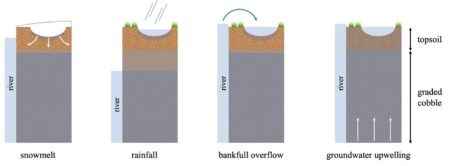
Potential sources of water in surface depressions within a floodplain of a snowmelt-dominated catchment.
Nitrate is an important compound that influences water quality and ecosystem health. Floodplains are important landscape features directly related to water quality, since they can control how much nitrate makes it into a stream. To help clarify which features of floodplains contribute the most to controlling nitrate fluxes, researchers looked at processes that produce and consume nitrate in floodplain surface depressions. Since surface depressions accumulate water, they provide an ideal environment for microbes that consume nitrate. Researchers found that surface depressions can prevent significant amounts of nitrate from reaching the stream, and that this behavior depends on whether the water comes from rainfall, snowmelt, or stream overflow.
The processes that control how much nitrate enters streams and how much nitrate leaves a watershed are very complex. These processes range across many scales, from microbes to mountains. To help scientists determine which processes and features are most important, we quantified not only how but when floodplain surface depressions impact the amount of nitrate that passes through the floodplain. These results can be used by scientists looking to understand the processes that control nitrate dynamics in larger scale systems.
Summary
Understanding multi-scale controls on nitrogen cycling is needed to predict watershed nitrogen retention and release under climatic perturbations. This is especially important for predicting changes in water quality in mountainous headwaters, which supply water to a majority of the western U.S.
In this study, researchers used numerical simulations to quantify nitrogen cycling within floodplain surface depressions (hollows), which are potentially one of many control points for nitrogen cycling within watersheds. The authors focused on the effects of transient hydrologic and geochemical conditions, including varying surface infiltration rates and varying water compositions as determined by the source of the water. Since the study site is located within a snowmelt-dominated catchment, the authors considered infiltration due to snowmelt, rainfall, stream overflow, and groundwater upwelling. The study found that the hollows primarily remove nitrogen from the floodplain system, with rainfall being the most significant cause of this “sink” behavior. This is important considering several mountainous watersheds are showing increasing rainfall and decreasing snowfall, meaning the sink behavior of these hollows may become more amplified. The study also used loose scaling methods to show that hollows prevent a significant amount of nitrogen from reaching the stream, emphasizing their role as control points for nitrogen retention and release.
Citation
D.B. Rogers, et al., “Modeling the impact or riparian hollows on river corridor nitrogen exports.” Frontiers in Water 3, (2021). [DOI: 10.3389/frwa.2021.590314]
